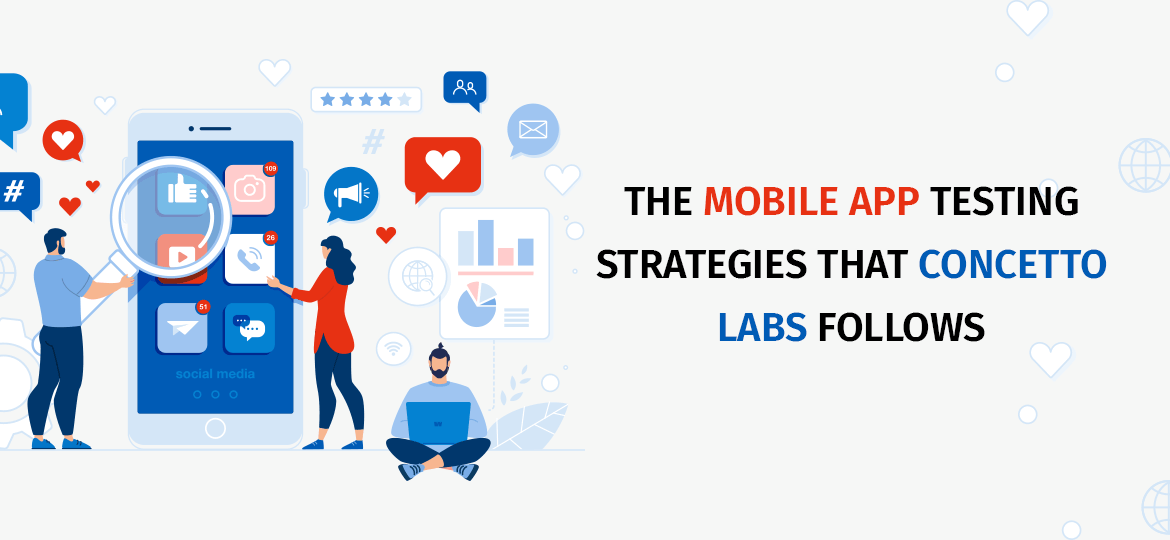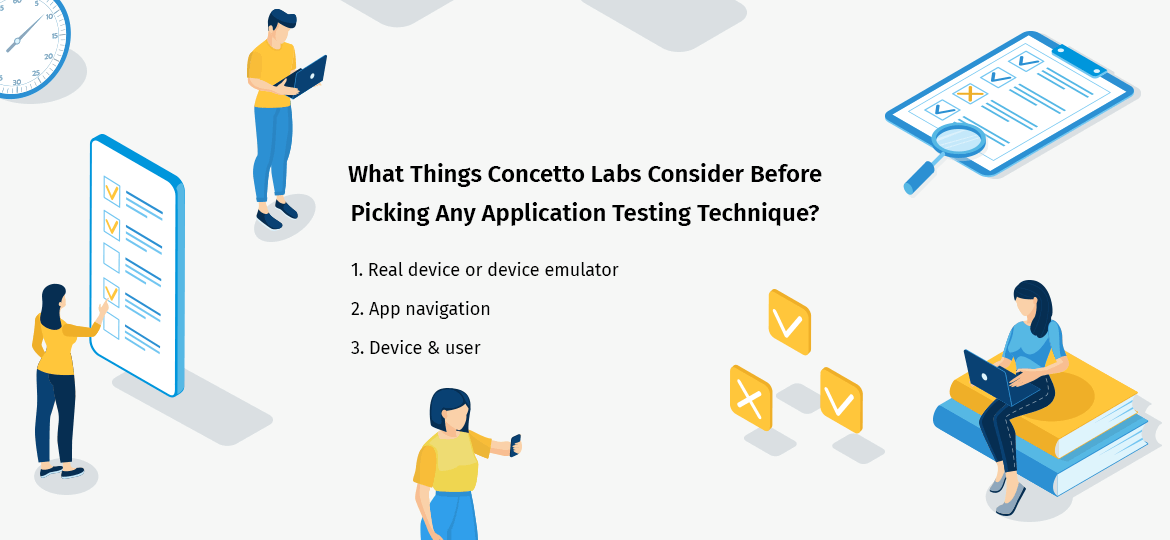
A mobile app is nothing if it fails to offer that seamless experience to its users, which they expect from it. An app which is considered majorly to be a technical piece, is much more than it, as there is the integration of coding, technology, and testing. Mobile app testing is a mandatory aspect for every business, to help it grow successful, because the mobile app testing strategies, define how far users would love to use your app.
Many strategies are picked to make the process a smooth journey. At Concetto Labs, we have a team of expert testers, who have helped many businesses to get an efficient app solution due to our practiced app testing strategies. In this post, we have discussed the strategies that Concetto labs follows and how it has helped them to deliver unmatched performance beyond the client’s expectations.
How Long Does It Take for Mobile App Testing To Happen?
App testing is not just a one-time process, but it goes along with the development journey. As your app makes progress, the testing goes with it. It is the process that happens during the development, before deployment, and during the app, maintenance to provide a smooth user experience.
What Things Concetto Labs Consider Before Picking Any Application Testing Technique?

1. Real device or device emulator
Many companies prefer real devices over the device emulator, but what they fail to understand is that it depends on the market needs and the devices they want to test the app on. And both of these have their benefits and drawback. When you use real devices, then definitely there is a guarantee of getting reliable and accurate results. This helps in checking the device performance while using the app, as the users would be using the same devices. And it does not give any type of false indication to the users. But on the other hand, you can’t forget that real devices need maintenance and it requires many to arrange the devices as well, because not every device used by the users is available instantly.
For the mobile device emulators, there are many advantages as well, where QA testers can create a similar environment such as the real device. These emulators are free and open-source, which helps the testes to study the unexpected behavior. Also, these emulators can be connected to an IDE for testing in the early stages of development.
But there are some disadvantages as well like emulators don’t work as fast as the real device which consumes time in testing. Also, these emulators don’t consider factors like battery drainage/overheating or conflicts with other preinstalled apps. There will be no support available for all the OS versions, and it can be expensive to build a good emulator, and that consumes time as well. Thus, it depends on your app requirements, and accordingly, we pick the right method of testing for it.
2. App navigation
Although the app navigation is part of the interface only, there is a reason we have mentioned it as a separate factor. We carry out specific testing for the application flow, where we keep a strong eye on the good design. As we know that an efficient app design brings together visual elements in the app, consisting of content, features, and functionality. With the efficient visual flow, your app guides users through the mobile product. We test the flow of your mobile app architecture. This helps us to find out any element in the app design, that obstruct the users’ aim to complete any of their desired tasks.
3. Device & user
Before starting the testing for any app, our first goal is to understand the users of that particular app, and which type of devices they use. Our team of testers selects the mobile application testing types based on this. We study, research, and plan the testing criteria that would fit that specific app type, and then we start the testing process afterward, where we select 5 – 10 devices that are most relevant. And on these devices, we start doing the testing. To keep ourselves updated and well-informed, we keep a sheet of every feature testing and write testing results against each feature. This helps us in understanding the rhythm of the testing process and let us pick the most relevant testing types for your app.
What Mobile App Testing Strategies Are Followed By A Leading Mobile App Development Company Like Concetto Labs?
Performance testing
A mobile app has a simple aim to bring comfort and convenience for the users from every possible aspect, and to achieve this it is farthest better for your device to conduct the performance testing. With this testing type, it becomes easy for the app owners to get understand any issue coming in the app. At XYZ, we run different tests on the app to check its performance. The typical tests we run to check if the app would run smoothly are:
- Load testing
- Stress testing
- Endurance testing
- Spike testing
Automated testing
Automated testing is mainly used to test repetitive use cases, where different types of basic functionalities get tested. This brings predictable and many verifiable results for the users. This type of testing allows the testers to conduct that type of testing on different features and functionalities of the app, which are not possible through the manual testing model.
Manual testing
Manual testing, as the name suggests it majorly runs through manual mode, where the app’s look and feel get tested. It is easy to navigate any type of existing and hidden bug within the app, which might have left unnoticed during any other type of testing. But manual testing brings those bugs in the limelight and helps in testing the complicated app scenarios. We ensure to follow the combination of 80/20 ratio to test the app, which helps in saving time and money both.
Security testing
The app data is at the constant threat of being breached by hackers always. The technical advancement has brought a new factor in the existence, where the app security is not always safer. There are some miscreants out there, who can fiddle with your app security. To overcome this issue, security testing is the best mode to remove the hurdle, you can hire QA analysts from us to create a smooth app product.
UI testing
Once you conduct this testing, it helps you understand that if your developed app solution is easy and intuitive to work with, and whether it meets the users’ expectations as well.
Network connectivity
On average a larger number of mobile apps for different industry verticals work on the network connection to work properly. But when a mobile app gets built, it becomes a hard task for the developers to check the efficiency of a mobile app on different networks. This does not limit the testing on one specific area but must be considered when a user travels to other cities and countries. And they need to understand that how much foreign travel will affect the app performance. To make this issue get changed into a normal condition, we conduct the network connectivity testing, where we test the app on the cloud testing platform to find out the solution.
Conclusion
If you want to win at the testing strategy, then you must practice these bulletproof strategies with Concetto Labs. You can Hire Quality Assurance strategists from us and give a new dimension to your app testing model.
Comments
Post a Comment